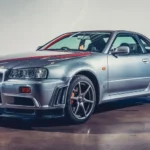The Suzuki Hayabusa and BMW S 1000 RR are two of the most iconic and powerful superbike models ever made. With insane power-to-weight ratios, loaded with technology, and wrapped in aggressive styling these machines offer some of the most scintillating performance on two wheels.
But which one is the better choice for you? This comprehensive comparison of the Hayabusa and BMW S 1000 RR breaks down all the key metrics, features, and ownership considerations to help you decide.
Suzuki Hayabusa Overview
- Legendary heritage as the world’s fastest production bike
- 1340cc ultra-high performance engine makes 190+ bhp
- Smooth, comfortable ergonomics for sport touring
- The 2022 update gets new electronics and sharper styling
BMW S 1000 RR Overview
- Race-derived 999cc inline 4 makes 205 bhp
- Cutting-edge electronics and rider aids
- Lightweight chassis and track-focused ergonomics
Performance and Handling Comparison
Both the Hayabusa and S 1000 RR deliver incredible acceleration and massive top-end power, but they go about it in different ways.
MetricSuzuki HayabusaBMW S 1000 RR
Engine 1340cc Inline 4 999cc Inline 4
Max Horsepower 190+ bhp 205 bhp
Max Torque 93 lb-ft 83 lb-ft
Redline 10,500 rpm 14,600 rpm
Dry Weight 586 lbs 434 lbs
- The Hayabusa makes peak torque lower in the rev range for effortless thrust
- The BMW makes 15 more peak horsepower and loves to scream up high
The S 1000 RR has a significant weight advantage which gives it slightly quicker acceleration and more agile handling. The Hayabusa is no slouch though and has tons of low-end grunt.
Both bikes feature a comprehensive electronics suite including:
- Anti-lock brakes
- Multiple rider modes
- Wheelie control
- Launch control
- Cornering ABS
So they are well matched when it comes to utilizing all that power. The BMW may have the edge when it comes to arm-wrenching performance but the Hayabusa delivers plenty of speed and excitement at a fast pace.
Features and Technology Comparison
As the Hayabusa soldiers on with its 1340cc engine and comfortable ergos, it sticks to a more old-school analog design. The quad exhaust, bulging bodywork, and dual stitched seat all scream vintage 1990s Homologation Superbike.
In contrast, the BMW S 1000 RR matches exotic MotoGP tech with a slim, track-focused design. Valves made from titanium, adjustable (##suspension##), adaptive turn signals and M Carbon wheel options help justify its premium price.
So when it comes to the wow factor, the cutting-edge BMW steals the show. But some riders will still prefer the iconic, muscular presence of the Hayabusa.
Accessories and Customizations
One of Hayabusa’s calling cards over its long production run is the massive aftermarket catalog of parts and accessories. You can equip your Busa with:
- Slip-on exhausts
- Engine tuning tools
- Custom rearsets
- Wide saddlebags
- Integrated cameras
- All kinds of cosmetic upgrades
As the ultimate track weapon, most BMW owners focus on reducing weight rather than adding bulk. But you can still equip an S 1000 RR with:
- Adjustable clip-on handlebars
- Akrapovic exhaust cans
- Rear stand paddock stands
- Tail tidies
The Hayabusa also has a thriving turbo kit market, allowing properly equipped Busas to break the 300 kph barrier.
Just don’t expect BMW to honor your warranty after you’ve bolted a snail cam onto your S 1000 RR!
Ownership Considerations
If you’re lucky enough to own one of these German or Japanese superbikes, what’s the long-term outlook?
Reliability and Maintenance
- Both bikes should deliver years of trouble-free enjoyment when properly maintained
- More frequent valve clearance checks are required on BMW’s stratospheric 14,600 rpm redline
- Hayabusa engine is stone axe reliable; can easily accumulate big miles
Insurance and Costs
- Expect higher premiums to insure these extremely high-performance bikes
- More electronics mean pricier replacement parts
- Exotic materials drive up prices on BMW consumables
Resale Value
- Early Suzuki Hayabusas already command collectible status
- Certain anniversary editions will only go up in value
- BMW S 1000 RR is unlikely to become a future classic due to continual model updates
So in many ways, the less complex Hayabusa is simpler and cheaper to own long-term. But the BMW S 1000 RR offers more advanced performance and prestige if you can afford it.
Conclusion and Recommendation
While the updated Suzuki Hayabusa delivers incredible acceleration wrapped in comfort and iconic styling, we have to give the narrow victory to the BMW S 1000 RR. Its higher-spec engine, advanced electronics, and featherweight chassis allow it to dominate on both road and track. Light, fast, and dangerous, it lives up to its World Superbike heritage.
That said, the mighty ‘Busa remains a brutally quick machine with a badge valued by riders worldwide. Rest assured that either superbike will put a demonic grin on your face every time you crack open the throttle!
Frequently Asked Questions
Which superbike has the higher top speed?
The Suzuki Hayabusa holds the edge for outright, real-world top speed. In stock form it can hit speeds over 190 mph, leading most governments to cap its performance. The BMW S 1000 RR has a lower top speed of around 185 mph but feels faster due to its higher horsepower engine and rapid acceleration.
Which bike handles better through corners?
The BMW S 1000 RR is designed for track use and carves corners better thanks to its featherweight construction and race-tuned suspension. The Hayabusa is still extremely capable however and delivers sporty handling despite its bigger frame and supple suspension.
Which bike offers more comfortable ergonomics?
The Suzuki Hayabusa without question. Its roomy riding position, wide bars, and plush seat work great for longer sport touring rides. The BMW S 1000 RR cants the rider forward into an aggressive stance ideal for track days but taxing to comfort over time. Taller riders may also find the S 1000 RR a tighter fit.
Which superbike has the better electronics and rider aids?
As BMW’s flagship superbike, the S 1000 RR comes loaded with electronics and rider aids tuned at the highest levels of racing. From auto launch control to variable traction control, few can match BMW’s wizardry. That said, the updated Hayabusa now runs a very capable iMu-based suite with all the essentials for going fast and safely. Serious track riders may still prefer the BMW’s cutting-edge options.









